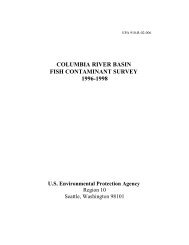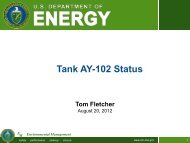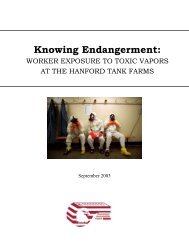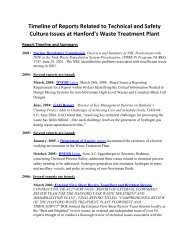Reducing the Risks of High-Level Radioactive Wastes at Hanford
Reducing the Risks of High-Level Radioactive Wastes at Hanford
Reducing the Risks of High-Level Radioactive Wastes at Hanford
Create successful ePaper yourself
Turn your PDF publications into a flip-book with our unique Google optimized e-Paper software.
82 Alvarez<br />
N<strong>at</strong>ional Labor<strong>at</strong>ory, PNNL-13901, May 2002, Interim closure involves “placing tanks<br />
th<strong>at</strong> no longer contain any retrievable waste and are considered to be into a safe, stable,<br />
and minimum maintenance condition until final closure could occur. This st<strong>at</strong>e <strong>of</strong> prefinal<br />
closure (o<strong>the</strong>rwise known as interim closure, oper<strong>at</strong>ional closure, etc.) was termed<br />
tank lay-up.”<br />
120. DOE/ORP-2002-03, p. 10.18) “Notably, borehole logging in SX Tank Farm revealed<br />
137Cs <strong>at</strong> depths <strong>of</strong> 40 meters (130 ft), significantly deeper than predicted by current<br />
models. Fur<strong>the</strong>r investig<strong>at</strong>ions, including <strong>the</strong> drilling <strong>of</strong> two additional wells, confirmed<br />
<strong>the</strong> presence <strong>of</strong> migr<strong>at</strong>ed cesium in <strong>the</strong> form<strong>at</strong>ion. The report issued by <strong>the</strong> RPP Vadose<br />
Zone Expert Panel concluded th<strong>at</strong> cesium migr<strong>at</strong>ion was poorly understood and th<strong>at</strong><br />
insufficient d<strong>at</strong>a were available to valid<strong>at</strong>e migr<strong>at</strong>ion models ... Fur<strong>the</strong>rmore, <strong>the</strong> vadose<br />
zone cleanup schedule for <strong>the</strong> 200 Areas could be delayed if <strong>the</strong> mobility st<strong>at</strong>us <strong>of</strong><br />
deeply distributed contaminants is unknown or inadequ<strong>at</strong>ely characterized well in advance.<br />
For example, if it is eventually determined th<strong>at</strong> retrieval <strong>of</strong> TRU-contamin<strong>at</strong>ed<br />
soil down to 40 m or more bene<strong>at</strong>h Plutonium Finishing Plant cribs is required, <strong>the</strong><br />
cleanup schedule could be gre<strong>at</strong>ly impacted by excav<strong>at</strong>ion and handling costs th<strong>at</strong> could<br />
approach 1 billion dollars or more. Similar excav<strong>at</strong>ion requirements for leaking SSTs<br />
could drive <strong>the</strong> costs <strong>of</strong> cleanup higher by several orders <strong>of</strong> magnitude. The sooner this<br />
issue is resolved, <strong>the</strong> sooner more accur<strong>at</strong>e technical, financial, and schedule forecasts<br />
can be made”<br />
121. DOE/ORP-2002-03, pp. 10.4, 10.6).<br />
122. Energy Reorganiz<strong>at</strong>ion Act <strong>of</strong> 1974, P.L. 93-438, Oct. 11, 1974, 88 St<strong>at</strong>. 1233, (U.S.C.<br />
Title 42, Sec. 5801 et seq.).<br />
123. The Nuclear Waste Policy Act, P.L. 97-425, Jan. 7, 1983, 96 St<strong>at</strong>. 2201 (Title 42,<br />
Sec. 10101 et seq.).<br />
124. Nuclear Waste Policy Amendments Act <strong>of</strong> 1987, P.L. 100-203, title V, subtitle<br />
A, Sec. 5001-5065, Dec. 22, 1987, 101 St<strong>at</strong>. 1330-227 to 1330-255. According to NRC<br />
(NUREG-1747, p. 215.). “Under <strong>the</strong> present system, unless <strong>the</strong> NRC determines th<strong>at</strong><br />
this LAW/incidental waste is not HLW, <strong>the</strong> waste must be disposed <strong>of</strong> as HLW in a<br />
federal repository.”<br />
125. NRC 1997 Approval Letter.<br />
126. NUREG/CR-5751, p. 1–18, “The daughters <strong>of</strong> Sr-90 and Cs-137 –Y-90 and Ba-137m<br />
respectively – are <strong>at</strong> or near a st<strong>at</strong>e <strong>of</strong> transient equilibrium (i.e. equal radioactivity)<br />
with <strong>the</strong>ir parents and should be included in <strong>the</strong> inventory.”<br />
127. WHC-SD-WM-TI-699 Rev. 2 1996) pp. ES vi, vii.<br />
128. U.S. Nuclear Regul<strong>at</strong>ory Commission, Letter to: Mr. Jackson Kinzer, Office <strong>of</strong> Tank<br />
Remedi<strong>at</strong>ion System, U.S. Department <strong>of</strong> Energy, Richland Oper<strong>at</strong>ions Office, From:<br />
Carl J. Paperiello, Director, Office <strong>of</strong> Nuclear M<strong>at</strong>erial Safety and Safeguards, June 9,<br />
1997. (Hereafter known as NRC 1997 Approval Letter.)<br />
129. WHC-SD-WM-TI-699.<br />
130. Ibid.<br />
131. IMAP.<br />
132. IMAP, Tank wastes scheduled for onsite disposal using “supplemental technologies”<br />
are found in IMAP (Acceler<strong>at</strong>ed Retrieval and Interim Closure Schedule Table 4.3,<br />
and Potentially Low Curie Low-Activity Waste Tanks Table 4.6). This estim<strong>at</strong>e excludes<br />
wastes in tanks C-104,106,107,S-105,106, and 112 scheduled to go to <strong>the</strong> Waste Tre<strong>at</strong>ment<br />
Plant, and, wastes in tanks identified as potential transuranic wastes and, thus<br />
is based on disposition <strong>of</strong> wastes in 62 SSTs.







